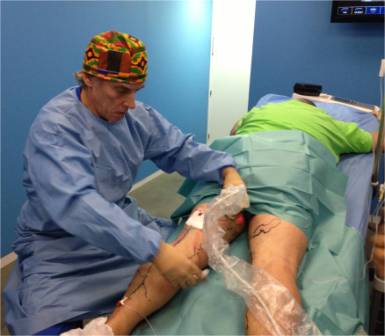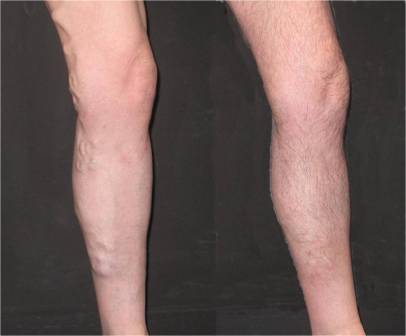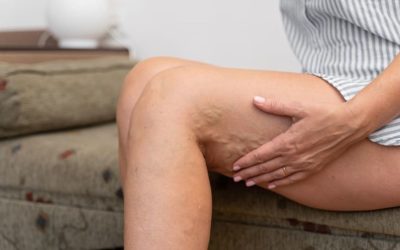This is the e-poster presented by Dr. Azpiazu at the 34th ASLMS meeting in April 2014 in Phoenix, Arizona (USA):
Background and Objectives
Varicose veins is a major medical disease in the world that affects 23% of adults. Endovenous thermal ablation has revolutionized the treatment of patients with chronic venous disease, considered a grade 1B recommendation for the treatment of saphenous incompetence. The objective of this study is to analyze the results of the first 400 cases treated with Endovenous Laser Ablation in a dermatology clinic.
Study Design and Methods
From November 2010 to July 2013, 400 limbs with varicose veins produced by great, small, anterior accessory great saphenous and perforator vein incompetence were treated.
All patients underwent a pre-procedure medical history assessment, physical examination and ultrasound evaluation (mapping). After administration of 1.0% lidocaine to the skin entry site, access was performed with Seldinger technique using a standard micropuncture kit and ultrasound localization. The fiber was advanced until 20 mm of the saphenofemoral junction (SFJ), where the SSV leaves the fascia and begins to descend to the saphenopopliteal junction (SPJ) or just immediately below the fascia for the perforators. Tumescent Klein solution anesthesia along the veins was used. Then a 1,320nm laser (CoolTouch) with automated fiber pull back device was used. Microflebectomy was performed in 45.5% of the cases. After the procedure a stocking was placed on the treated leg and patients were made to walk for 20-30 minutes. Follow-up was after 24-48 hours,1 month and 6 months.
The primary procedural efficacy was determined by a standardized duplex ultrasound protocol to determine whether the treated veins were open or closed in the treated segment during the follow-up intervals (48h, 1 month and 6 months). Secondary clinical efficacy was determined with CEAP and VCSS score (48h, 1 month and 6 months). Side effects evaluated were infection, phlebitis, skin hyperpigmentation, postoperative paresthesias, recanalization, endovenous heat induced thrombosis (EHIT) and fractured endovenous laser fiber.

Results and Conclusions
400 treated limbs in 282 patients, 67 patients were treated on both legs, 303 females (76%), 97 males (24%), mean age 51 years (21-85). 71% of the patients sought treatment primarily for pain or restless leg relief and 29% for the appearance of the leg. 0.32% were CEAP 6, C5: 0.95%, C4: 2.55%, C3: 21.34%, C2: 72.93% and C1: 1.91%

Conclusions: Endovenous Laser Ablation is an effective, safe and highly tolerated procedure that allows patients to return to their daily routine immediately after treatment.
BACKGROUND AND OBJECTIVES
Varicose veins is a major medical disease in the world that affects 23% of adults. Endovenous thermal ablation has revolutionized the treatment of patients with chronic venous disease, considered a Grade 1B recommendation for the treatment of saphenous incompetence. The objective of this study is to analyze the results of the first 400 cases treated with Endovenous Laser Ablation in a dermatology clinic.
STUDY DESIGN AND METHODS
From November 2010 to July 2013, 400 limbs with varicose veins produced by great, small, anterior accessory great saphenous and perforator vein incompetence were treated. All patients underwent a pre-procedure medical history assessment, physical examination and ultrasound evaluation (mapping).
The procedure was performed in an outpatient setting. After administration of 1.0% lidocaine to the skin entry site, access was performed with Seldinger technique using a standard micropuncture kit and ultrasound localization. The fiber was advanced until 20mm of the saphenofemoral junction (SFJ) , where the SSV leaves the fascia and begins to descend to the saphenopopliteal junction (SPJ) ) or just immediately below the fascia for the perforators. Tumescent Klein solution anesthesia along the veins alone without sedation was used. Then, a 1,320nm laser (CoolTouch) with automated fiber pull back device was used. Microflebectomy was performed in 45.5% of the cases. After the procedure, a stocking was placed on the treated leg and patients were made to walk for 20-30 minutes. The follow-up was after 24-48 hours, 1 month and 6 months.
Age, gender, venous location, CEAP and VCSS scores, access numbers, access sites, length of the GSV, SSV and AAGSV treated, SFJ and SPJ diameters, fluence, distance from fiber tip to SFJ, treatment time, distance from thrombus to SFJ or SPJ 48-72h follow-up, endovenous heat induced thrombosis 48-72h follow-up were studied. The primary procedural efficacy was determined by a standardized duplex ultrasound protocol to determine whether the treated veins were open or closed in the treated segment during the follow-up intervals (48h, 1 month and 6 months). Secondary clinical efficacy was determined with CEAP and VCSS score (48h, 1 month and 6 months). Side effects evaluated were infection, phlebitis, skin hyperpigmentation, postoperative paresthesias, recanalization, endovenous heat induced thrombosis (EHIT) and fractured endovenous laser fiber.
RESULTS
400 treated limbs in 282 patients, 67 patients were treated on both legs, 303 females (76%), 97 males (24%); mean age 51 years (21-85); 71% of the patients sought treatment primarily for pain or restless leg relief and 29% for the appearance of the leg. 0.32% were CEAP 6, C5: 0.95%, C4: 2.55%, C3: 21.34%, C2: 72.93% and C1: 1.91%
Access sites were below the knee in 340 cases (85%) and above the knee in 60 (15%). Double access had to be performed in 41 cases (10.25%) due to problems encountered while advancing the guide wire or the fiber along the vein. Mean length of GSV treated was 46.6 cm (8.8-74.5); SSV: 20.87 (3-38); AASV: 23.84 (2-54.5). The average SFJ diameter was 8.29 mm (1.9-16). Mean fluence used was 3,776.92 jul. Mean treatment time was 66.58 minutes (15-150). All patients were able to resume their daily routine immediately after the procedure, some even returning to work after the treatment.
There were 2 cases of fractured endovenous laser fiber. In one of those cases, the fiber had to be surgically pulled out.
At 48-72 hour follow-up 99.5% of treated veins remained closed by ultrasound criteria. There were two perforator vein which were recanalized. The mean distance from area treated to SFJ was 9.66mm. There were nine cases (2.25% of the cases) with thrombus that reached the junction, (Endovenous Heat Induced Thrombosis), eight of them just to the limit of the SFJ, and one extending into the deep system less than 25% of the diameter. This patient was treated with low molecular weight heparin, and in the follow-up one week later, the thrombus had diminished in size reaching the SFJ limit. No infection or phlebitis was observed. VCSS improved in 94.19% of the cases.
At the 30-day follow-up 99% of treated veins remained completely closed by ultrasound criteria. There were two perforator veins and two GSV cases with recanalization. CEAP improved in 82.63% of cases, and both the symptoms and VCSS in 99.01%, ranging from a mean of 4.27 to 0.54. Skin hyperpigmentation along the treated vein occured in 20.25%; postoperative paresthesias in 8.5% and phlebitis in 0,26% of cases.
At the 60-month follow-up 98.75% of treated vein segments remained completely closed by ultrasound criteria. There were two perforator veins and three GSV cases with recanalization. CEAP score improved in 92.65% of the cases and the symptoms and VCSS in 100%. Skin hyperpigmentation along the treated vein occured in 11.25% and postoperative paresthesias in 2.5% of cases.

CONCLUSIONS
Endovenous Laser treatment is an effective, safe and highly tolerated procedure that allows patients to return to their daily routine immediately after the treatment.





